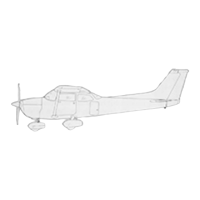SECTION
3
EMERGENCY PROCEDLIRES
CESSNA
MODEL 182T NAV
Ill
ROUGH ENGINE OPERATION OR LOSS OF
POWER
(Continued)
EXCESSIVE FUEL VAPOR
Fuel vapor in the fuel injection system is most likely to occur on the
ground, typically during prolonged taxi operations, when operating
at higher altitudes
and/or in unusually warm temperatures.
Excessive fuel vapor accumulation is shown by fuel flow indicator
(FFLOW GPH) fluctuations greater than 1
gal./hr. This condition,
with leaner mixtures or with larger fluctuations, can result in power
surges, and if not corrected, may cause power loss.
To slow vapor formation and stabilize fuel flow on the ground or in
the air, set the FUEL PUMP switch to the ON position and adjust
the mixture as required for smooth engine operation. If vapor
symptoms continue, select the opposite fuel tank. When fuel flow
stabilizes, set the FUEL PUMP switch to the OFF position and
adjust the mixture as desired.
LOW OIL PRESSURE
If the low oil pressure annunciator (OIL PRESS) comes on, check
the oil pressure indicator (OIL PRES on ENGINE page or OIL PSI
on SYSTEM page) to confirm low oil pressure condition. If oil
pressure and oil temperature (OIL TEMP on ENGINE page or OIL
OF on SYSTEM page) remain normal, it is possible that the oil
pressure sending unit or relief valve is malfunctioning. Land at the
nearest airport to determine the source of the problem.
If a total loss of oil pressure and a rise in oil temperature occur at
about the same time, it could mean that the engine is about to fail.
Reduce power immediately and select a field suitable for a forced
landing. Use only the minimum power necessary to reach the
landing site.

